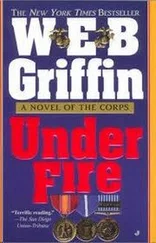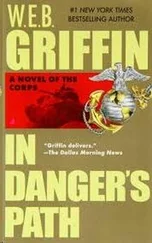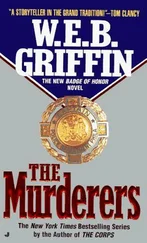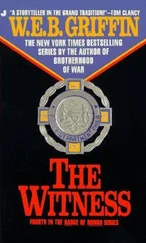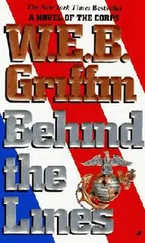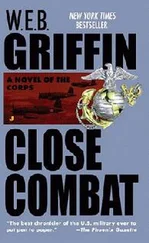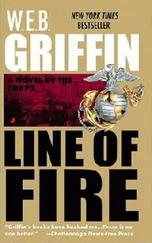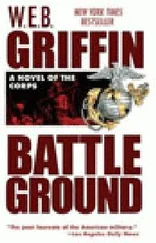W.E.B. Griffin - The Corps 03 - Counterattack
Здесь есть возможность читать онлайн «W.E.B. Griffin - The Corps 03 - Counterattack» весь текст электронной книги совершенно бесплатно (целиком полную версию без сокращений). В некоторых случаях можно слушать аудио, скачать через торрент в формате fb2 и присутствует краткое содержание. Жанр: prose_military, на английском языке. Описание произведения, (предисловие) а так же отзывы посетителей доступны на портале библиотеки ЛибКат.
- Название:The Corps 03 - Counterattack
- Автор:
- Жанр:
- Год:неизвестен
- ISBN:нет данных
- Рейтинг книги:4 / 5. Голосов: 1
-
Избранное:Добавить в избранное
- Отзывы:
-
Ваша оценка:
- 80
- 1
- 2
- 3
- 4
- 5
The Corps 03 - Counterattack: краткое содержание, описание и аннотация
Предлагаем к чтению аннотацию, описание, краткое содержание или предисловие (зависит от того, что написал сам автор книги «The Corps 03 - Counterattack»). Если вы не нашли необходимую информацию о книге — напишите в комментариях, мы постараемся отыскать её.
The Corps 03 - Counterattack — читать онлайн бесплатно полную книгу (весь текст) целиком
Ниже представлен текст книги, разбитый по страницам. Система сохранения места последней прочитанной страницы, позволяет с удобством читать онлайн бесплатно книгу «The Corps 03 - Counterattack», без необходимости каждый раз заново искать на чём Вы остановились. Поставьте закладку, и сможете в любой момент перейти на страницу, на которой закончили чтение.
Интервал:
Закладка:
By the time he was down to fifteen hundred feet over the smooth, dark blue Pacific, and headed straight for the Saratoga ’s bow, she had completed her turn into the wind. Galloway looked down at her deck and saw that she was indeed ready to receive him. He could see faces looking up at him, and he could see that the cables had been raised. And when he glanced at her stern, he could see the Landing Control Officer, his paddles already in hand, waiting to guide him aboard.
He started to lower his landing gear.
He did not do so in strict accordance with Paragraph 19.a.(l) of AN 01-190FB-1, which was the U.S. Navy Bureau of Aeronautics Pilot’s Handbook of Flight Operating Instructions for F4F-Series Aircraft. Paragraph 19.a.(l), which Charley Galloway knew by heart, said, "Crank down the landing gear." Then came a CAUTION: "Be sure the landing gear is fully down."
The landing gear on the Wildcat, the newest and hottest and most modern fighter aircraft in the Navy’s (and thus the Marine Corps’) arsenal, had to be cranked up and down by hand. There was a crank on the right side of the cockpit. It had to be turned no less than twenty-nine times either to release or retract the gear. The mechanical advantage was not great, and to turn it at all, the pilot had to take his right hand from the stick and fly with his left hand while he cranked hard, twenty-nine times, with his right hand.
Charley Galloway had learned early on-he had become a Naval Aviator three days after he turned twenty-one-that there wasn’t room in the cockpit for anyone to come along and see how closely you followed regulations.
The records of VMF-211 indicated that Charles M. Galloway was currently qualified in F2A-3, F4F-4, R4D, and PBY-5 and PBY-5A aircraft.
The R4D was the Navy version of the Douglas DC-3, a twin-engined, twenty-one passenger transport, and the PBY-5 was the Consolidated Catalina, a twin-engined seaplane that had started out as sort of a bomber and was now primarily used as a long-range observation and antisubmarine aircraft. The PBY-5 A was the amphibian version of the PBY-5; retractable gear had been fitted to it.
The Marine Corps had no R4D and PBY-5 aircraft assigned to it; Charley Galloway had learned to fly them when he and some other Marine pilots had been borrowed from the Corps to help the Navy test them, get them ready for service, and ferry them from the factories to their squadrons. He had picked up a lot of time in the R4D, even going through an Army Air Corps course on how to use it to drop parachutists.
He was therefore, in his judgment, a good and experienced aviator, with close to two thousand hours total time, ten times as much as some of the second lieutenants who had just joined VMF-211 as replacements. He was also, in his own somewhat immodest and so far untested opinion, one hell of a fighter pilot, who had figured out a way to get the goddamned gear down without cranking the goddamned handle until you were blue in the face.
It involved the physical principle that an object in motion tends to remain in motion, absent restricting forces.
Charley had learned that if he unlocked the landing gear, then put the Wildcat in a sharp turn, the gear would attempt to continue in the direction it had been going. Phrased simply, when he put the Wildcat in a sharp turn, the landing-gear crank would spin madly of its own volition, and when it was finished spinning, the gear would be down. All you had to do was lock it down. And, of course, remember to keep your hand and arm out of the way of the spinning crank.
He did so now. The crank spun, the gear went down, and he locked it in place.
Then, from memory, he went through the landing check-off list: he unlocked the tail wheel; he lowered and locked the arresting hook, which, if things went well, would catch one of several cables stretched across the deck of the Saratoga and bring him to a safe but abrupt halt
He pulled his goggles down from where they had been resting on the leather helmet, and then slid open and locked the over-the-cockpit canopy.
He pushed the carburetor air control all the way in to the Direct position, retarded the throttle, and set the propeller governor for 2100 rpm. He set the mixture control into Auto Rich, opened the cowl flaps, and lowered the wing flaps.
All the time he was doing this, he was turning on his final approach, that is to say, lining himself up with the deck of the Saratoga.
The Landing Control Officer was ready for him. Using his paddles, he signaled to Charley Galloway that he was just a hair to the right of a desirable landing path. Then, at the last moment, he made his decision, and signaled Charley to bring it in and set it down.
Charley’s arresting hook caught the first cable, and the Wildcat was jerked to a sudden halt with a force that was always astonishing. Whenever he made a carrier landing, Charley Galloway felt an enormous sense of relief, and then, despite a genuine effort to restrain it, a feeling of smug accomplishment. Ships and airplanes were different creatures. They were not intended to mate on the high seas. But he had just done exactly that. Again. This made Carrier Landing Number Two Hundred and Six.
And there weren’t very many people in the whole wide world who could do that even once.
As the white hats rushed up to disengage the cable, he quickly went through the "Stopping the Engine" checklist, again from memory.
By the time the propeller stopped turning and he had shut off the ignition, battery, and fuel selector switches, a plane captain was there to help him get out of the cockpit. And he saw Major Verne J. McCaul, USMC, Commanding Officer of VMF-221, standing on the deck, smiling at him. VMF-221, equipped with fourteen F2A-3 Brewster Buffalos, was stationed aboard the Saratoga. Galloway had known him for some time, liked him, and was glad to see him.
Charley jumped off the wing root and walked to him. "I am delighted," said Major McCaul, who was thirty-five and looked younger, "nay, overjoyed to see you."
Galloway looked at him suspiciously.
"The odds were four to one you’d never make it out here," McCaul said. "I took a hundred bucks’ worth at those odds, twenty-five of them for you."
"You knew I was coming?"
"There was a radio from Pearl about an hour ago," McCaul said.
Apparently it didn’t say "arrest on sight," or there would be a Marine with irons waiting for me.
"Well, that certainly was very nice of you, Sir," Galloway said, not absolutely sure that McCaul wasn’t pulling his leg.
Proof that he was not came when McCaul handed him five twenty-dollar bills.
It then occurred to him that he had, literally, jumped from the frying pan into the fire. He had made it this far. But the next stop was Wake Island. The odds, bullshit aside, that Wake could be held against the Japanese seemed pretty remote. He had no good reason to presume that he would be any better a pilot, or any luckier, than the pilots of VFM-211 on Wake who had already been shot down.
Then he remembered what Big Steve Oblensky had once told him. The function of Marines was to stop bullets for civilians; that’s what they were really paying you for.
"The Captain wants to see you after you’re cleaned up," Major McCaul said. "In the meantime, I’m sorry to have to tell you, you’re to consider yourself under arrest."
"Am I in trouble that deep, Major?"
"I’m afraid so, Charley. The Navy’s really pissed," Major McCaul said. "I’ll do what I can for you, but ... they’re really pissed."
"Oh, hell," Charley said. And then, not too convincingly, he smiled. "Well, what the hell, Major. What can they do to me? Send me to Wake Island?"
Chapter Two
(One)
Washington, D.C.
19 December 1941
As his taxi drove past the White House, Fleming Pickering, a tall, handsome, superbly tailored man in his early forties, noticed steel-helmeted soldiers, armed with rifles, bayonets fixed, guarding the gates.
Читать дальшеИнтервал:
Закладка:
Похожие книги на «The Corps 03 - Counterattack»
Представляем Вашему вниманию похожие книги на «The Corps 03 - Counterattack» списком для выбора. Мы отобрали схожую по названию и смыслу литературу в надежде предоставить читателям больше вариантов отыскать новые, интересные, ещё непрочитанные произведения.
Обсуждение, отзывы о книге «The Corps 03 - Counterattack» и просто собственные мнения читателей. Оставьте ваши комментарии, напишите, что Вы думаете о произведении, его смысле или главных героях. Укажите что конкретно понравилось, а что нет, и почему Вы так считаете.

